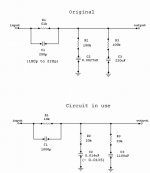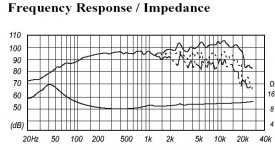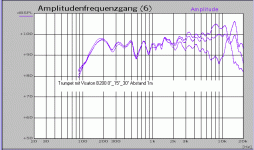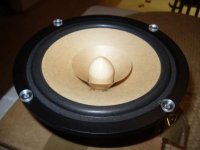ARTA CSD & CBSD
Hi Geoff,
acc to my knowledge ATB shows periods and not time. It's a period based CSD.
Here are the two types for a Solo 20 (B200 in 20 ltr CB)
Normal CSD
"period based CSD"
Regards
Heinrich
Hi Geoff,
acc to my knowledge ATB shows periods and not time. It's a period based CSD.
Here are the two types for a Solo 20 (B200 in 20 ltr CB)
An externally hosted image should be here but it was not working when we last tested it.
Normal CSD
An externally hosted image should be here but it was not working when we last tested it.
"period based CSD"
Regards
Heinrich
Re: ARTA CSD & CBSD
Indeed it does. A period CSD tells us much more about the ring down/settling response of a speaker.
dave
ente said:acc to my knowledge ATB shows periods and not time. It's a period based CSD.
Indeed it does. A period CSD tells us much more about the ring down/settling response of a speaker.
dave
So, I finally got around to trying this line level filter for the B200 with average parts; metal film R's and cheap styrene C's. Values were adjusted for an amp with 20k input impedance. There may be a pic below showing the value changes.
What I notice is a lot more high frequency(too much?) compared to the previous parallel LR at the speaker. Seems tilted up quite a bit but haven't measured yet. I'm guessing C1 is influencing the highs so I replaced C1 with a 750p better quality cap (Rel styrene) and let it run in a while. The over all quality of the highs improved and the sound stage focused much better(probably due to the better quality cap) but it is still pretty bright.
Did I screw up the values? Is calculating what C1 is doing just a matter of downstream impedance (20k)?
Thanks,
Scott
What I notice is a lot more high frequency(too much?) compared to the previous parallel LR at the speaker. Seems tilted up quite a bit but haven't measured yet. I'm guessing C1 is influencing the highs so I replaced C1 with a 750p better quality cap (Rel styrene) and let it run in a while. The over all quality of the highs improved and the sound stage focused much better(probably due to the better quality cap) but it is still pretty bright.
Did I screw up the values? Is calculating what C1 is doing just a matter of downstream impedance (20k)?
Thanks,
Scott
Attachments
How about taking away the C1 entirely at first,and working from there until the level suits your taste.
edit: But hey...... looks like you have mixed up some of the capacitor values.(C3 pF to uF).Have a look at the original circuit in first page.
edit: But hey...... looks like you have mixed up some of the capacitor values.(C3 pF to uF).Have a look at the original circuit in first page.
Oops, transcription error. C3 are actually pico's.
I'll fiddle with C1 some more and see what happens.
Scott
p.s. Just took the C1's out and it sounds more relaxed to my ears. S.
I'll fiddle with C1 some more and see what happens.
Scott
p.s. Just took the C1's out and it sounds more relaxed to my ears. S.
"and it sounds more relaxed to my ears"
Them's the ones we have to please.
Just wondering Scott, are you on OB? That can give a rise to the mids,
depending on baffle width / braces etc. Sounds impressive on vocals and percussion at first, then gets to you.
Geoff.
Them's the ones we have to please.
Just wondering Scott, are you on OB? That can give a rise to the mids,
depending on baffle width / braces etc. Sounds impressive on vocals and percussion at first, then gets to you.
Geoff.
Hey Geoff,
Yes, OB for me!
They're on a 2 ft. by 4 ft flat baffle. Have used a parallel LR filter at the speaker for quite a while- various L's and Mills WW R's, usually about 5 ohm. When I tried the LL filter I was surprised how much that parallel cap let the highs through. I may try that C in series with some R to scale it back a little. I may tend to like the highs rolled off just a bit due to the insults my hearing has had over the years.
From post #30 regarding an input cap to facilitate a high pass:
Sorry to be dense but could you explain a little more what this would look like?
Thanks,
Scott
Yes, OB for me!
They're on a 2 ft. by 4 ft flat baffle. Have used a parallel LR filter at the speaker for quite a while- various L's and Mills WW R's, usually about 5 ohm. When I tried the LL filter I was surprised how much that parallel cap let the highs through. I may try that C in series with some R to scale it back a little. I may tend to like the highs rolled off just a bit due to the insults my hearing has had over the years.
From post #30 regarding an input cap to facilitate a high pass:
An additional pot with a series R shunting after the input C, will give you an adjustable bass roll off freq. 80 to 240 Hz could be very useful in setting it up.
Sorry to be dense but could you explain a little more what this would look like?
Thanks,
Scott
Hi Geoff,
As the circuit proved to be very effective for Visaton B200, I was wondering if it should be possible to develop similar circuits for other fullrange speakers. For example, Fostex Fe206 is quite unlistenable without some sort of filtering.
Considering its frequency response, could you come up with the appropriate values for the PLL filter?
Thanks,
Vix
As the circuit proved to be very effective for Visaton B200, I was wondering if it should be possible to develop similar circuits for other fullrange speakers. For example, Fostex Fe206 is quite unlistenable without some sort of filtering.
Considering its frequency response, could you come up with the appropriate values for the PLL filter?
Thanks,
Vix
Attachments
Hello,
thats not true:
"For example, Fostex Fe206 is quite unlistenable without some sort of filtering."
The filter is listenable and most the time the area below 800 Hz
is the problem not the highs,
with a low mid horn you will not need a filter.
2 problem is a misinterpretation of the
measurement, they made with a IEC norm baffle
thats different from a small baffle with 25 cm.
Look my solutions of sat horns without filter and
98-102 dB 1W 1M from 120 HZ up.
thats not true:
"For example, Fostex Fe206 is quite unlistenable without some sort of filtering."
The filter is listenable and most the time the area below 800 Hz
is the problem not the highs,
with a low mid horn you will not need a filter.
2 problem is a misinterpretation of the
measurement, they made with a IEC norm baffle
thats different from a small baffle with 25 cm.
Look my solutions of sat horns without filter and
98-102 dB 1W 1M from 120 HZ up.
Attachments
I'm with Horst on this -206 'unlistenable without a filter'? What have you been doing to them? 😀 They're not exactly a soporific listen, with that rising response, but they're still one of the best FR units around at the price. A pair of phase plugs improves things of course, and I'm sure EnABLing them will reap rewards too, but stock, they're a good unit. My friend Ed runs an unmodified pair in his Vofo folded TQWTs and they're very effective, even to someone like me, who hates a bright sound. Sure, a filter will flatten things out, but its not an automatic requirement.
Hi,
Sorry for harsh words. I was mostly thinking about ways to cure the rising response, plus something more like a Line level baffle step correction, when these speakers are not used in a horn, but other types of enclosure, ML TL for example. I bet they don't need a BSC when used in a horn, and the phase plug could take care of the top end.
Regards,
Vix
Sorry for harsh words. I was mostly thinking about ways to cure the rising response, plus something more like a Line level baffle step correction, when these speakers are not used in a horn, but other types of enclosure, ML TL for example. I bet they don't need a BSC when used in a horn, and the phase plug could take care of the top end.
Regards,
Vix
Oh yes, it's useful in an MLTL (TQWT's extra gain is usually sufficient by itself), no argument at all there. Best simply done as part of the BSC circuit -usually it doesn't need much else. The plugs sort out the mids & top nicely too. 🙂
peterbrorsson said:Yup regarding Sonido!
Have tested SFR178 on OB and sound is really good. Lacking of bass of course but Q is really low, so no surprise. However a really even response with no shout.
BIB on the way for these so we'll see....
Cheers!
peterbrorsson said:Wrong image!
DISGUSTING!
yep- you're right ,with so low Qts these drivers are either for horn or OB with bass helper ;
but- oh boy, they are good .............

- Status
- Not open for further replies.
- Home
- Loudspeakers
- Full Range
- Visaton B200 - Taming the shout






